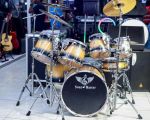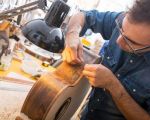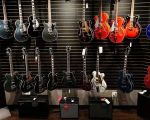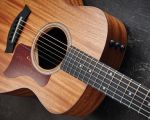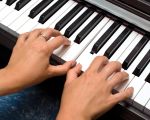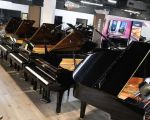Best Instruments for Building a Home Studio: Essential Gear for Music Production
When I first set out to build my own home studio, I had no idea where to begin. There are so many options, so many brands, and so many price points to consider. As someone who has been passionate about music production for years, I knew that creating a space where I could record, mix, and produce my own music was essential for taking my work to the next level. But building a home studio that’s both functional and affordable can be tricky. In this article, I’ll share the best instruments and equipment that I believe every aspiring music producer should consider when creating their own home studio.
1. Digital Audio Workstation (DAW): The Heart of Your Home Studio
When I started, I quickly realized that the first thing I needed was a solid Digital Audio Workstation (DAW). This software is the core of any music production studio. It's where all the magic happens, from recording and arranging to mixing and mastering. Choosing the right DAW for your home studio is crucial because it’ll define how you interact with your music and the overall workflow.
Over the years, I’ve tried a few DAWs, but there are a few standouts that I keep coming back to:
- Ableton Live: If you’re into electronic music or live performances, Ableton Live is hard to beat. Its intuitive interface and flexible features allow you to quickly lay down ideas and experiment with sounds. I love how seamless it is to manipulate loops and samples, which is perfect for my workflow.
- Logic Pro X: For those who prefer a more traditional approach to music production, Logic Pro X offers everything you need. It has a powerful set of virtual instruments and effects, making it ideal for a wide range of genres. I’ve used Logic for years and never felt the need to switch.
- FL Studio: If you’re just starting out or are on a budget, FL Studio is an excellent choice. It’s affordable, easy to learn, and packed with features. The interface is a little different from other DAWs, but once you get the hang of it, it becomes second nature.
Choosing the right DAW ultimately depends on your needs, budget, and personal preferences. I recommend trying out a few demos to see which one resonates with you the most.
2. Audio Interface: Connecting Everything to Your Computer
Once I selected my DAW, the next essential piece of equipment I invested in was an audio interface. An audio interface allows you to connect your instruments and microphones to your computer for recording and playback. It serves as the bridge between your music and your computer, ensuring that the sound quality is pristine.
Here are a few interfaces that I’ve personally used and recommend:
- Focusrite Scarlett 2i2: This is one of the most popular audio interfaces, and for good reason. It offers high-quality preamps, solid build quality, and easy-to-use software. I found it to be perfect for both beginners and more advanced producers.
- PreSonus AudioBox USB 96: If you're looking for a budget-friendly option that still delivers great quality, the PreSonus AudioBox is a solid choice. It’s compact and includes everything you need to get started with recording, including MIDI input/output.
- Universal Audio Apollo Twin: For professional-level production, the Apollo Twin is an industry standard. It’s on the pricier side, but the audio quality and plugins included are top-notch. I’ve used it for several projects, and the difference in sound clarity is immediately noticeable.
When choosing an audio interface, make sure it supports your DAW and fits your needs in terms of inputs/outputs. I recommend going with a reliable brand to ensure high-quality recordings.
3. MIDI Keyboard: Creating and Composing Music
One of the most important tools for music composition is a MIDI keyboard. While many people think of MIDI keyboards as just a way to control virtual instruments, they can also help you express ideas more fluidly. I’ve always loved having a physical keyboard at my fingertips when writing music—it makes the process much more intuitive.
There are plenty of MIDI keyboards to choose from, but here are some of my favorites:
- Akai MPK Mini MK3: This compact MIDI keyboard is perfect for small spaces and offers plenty of features like assignable pads and knobs, which makes it a great all-in-one controller. It’s especially useful for producers who want to work on the go.
- Arturia KeyLab Essential 49: If you’re looking for something a bit larger with more keys, the Arturia KeyLab is a fantastic choice. It offers a great balance between affordability and functionality, with responsive keys and an intuitive layout.
- Native Instruments Komplete Kontrol S61: For those who want to dive into high-end production, the Komplete Kontrol S61 provides a premium experience. It integrates seamlessly with the Native Instruments ecosystem and offers a wide range of features, including smart play modes and a professional-grade keybed.
When selecting a MIDI keyboard, consider the size and the number of keys you need, as well as the additional features like pads and knobs. These tools are invaluable when composing melodies, beats, and chords in your DAW.
4. Studio Monitors: Getting the Best Sound
Another essential component in my home studio setup is a pair of high-quality studio monitors. While headphones are great for detailed work, studio monitors give you an accurate representation of your sound, allowing you to make better mixing decisions. Having reliable monitors is critical if you want to ensure your music sounds good on all devices, whether it’s a phone, car speakers, or a nightclub sound system.
These are some of the best studio monitors I’ve used and highly recommend:
- Yamaha HS8: Known for their flat frequency response, the Yamaha HS8 monitors provide a precise and accurate sound, which is crucial for mixing and mastering. I love the clarity these speakers provide, especially in the midrange.
- KRK Rokit 5 G4: If you’re on a budget but still want great sound quality, the KRK Rokit 5 G4 monitors are an excellent choice. They’re known for their punchy bass and clear high-end, making them perfect for electronic music and hip-hop production.
- Adam Audio A7X: If you’re willing to invest in top-tier monitors, the Adam Audio A7X provides incredible accuracy and detail. These monitors deliver a perfect balance across the frequency spectrum, which helps me make precise mix adjustments.
When selecting studio monitors, I recommend considering the size of your room and the type of music you produce. It’s important to have monitors that provide a balanced sound for both low and high frequencies.
5. Acoustic Treatment: Improving Your Sound Environment
Lastly, one of the most important things I learned when setting up my home studio was the importance of acoustic treatment. No matter how great your instruments and gear are, if your room isn’t acoustically treated, the sound will be compromised. I added acoustic panels, bass traps, and diffusers to my studio to control the sound reflections and create a better mixing environment.
Acoustic treatment can be as simple or complex as you want it to be. For my home studio, I started with a few basic foam panels and gradually expanded from there. Some key acoustic products I recommend include:
- Auralex Acoustics Studiofoam Panels: These panels are great for reducing reflections and controlling room acoustics. They’re affordable, easy to install, and work wonders in small rooms.
- Primacoustic Full Room Kit: For those who want a more comprehensive solution, the Primacoustic Full Room Kit includes everything you need to treat your room, including bass traps, panels, and corner pieces.
- ATS Acoustics Panels: Known for their high-quality build, ATS Acoustics panels are another great option for treating your studio space. They help with sound clarity and eliminate unwanted noise, which is vital for high-quality recordings.
Acoustic treatment will make a world of difference when it comes to mixing and producing music. By controlling sound reflections and room modes, you’ll be able to hear your tracks more clearly and make better decisions.

